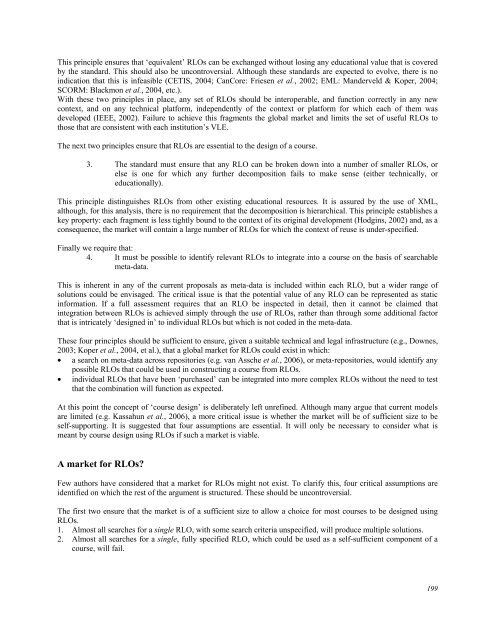October 2007 Volume 10 Number 4 - Educational Technology ...
October 2007 Volume 10 Number 4 - Educational Technology ...
October 2007 Volume 10 Number 4 - Educational Technology ...
Create successful ePaper yourself
Turn your PDF publications into a flip-book with our unique Google optimized e-Paper software.
This principle ensures that ‘equivalent’ RLOs can be exchanged without losing any educational value that is covered<br />
by the standard. This should also be uncontroversial. Although these standards are expected to evolve, there is no<br />
indication that this is infeasible (CETIS, 2004; CanCore: Friesen et al., 2002; EML: Manderveld & Koper, 2004;<br />
SCORM: Blackmon et al., 2004, etc.).<br />
With these two principles in place, any set of RLOs should be interoperable, and function correctly in any new<br />
context, and on any technical platform, independently of the context or platform for which each of them was<br />
developed (IEEE, 2002). Failure to achieve this fragments the global market and limits the set of useful RLOs to<br />
those that are consistent with each institution’s VLE.<br />
The next two principles ensure that RLOs are essential to the design of a course.<br />
3. The standard must ensure that any RLO can be broken down into a number of smaller RLOs, or<br />
else is one for which any further decomposition fails to make sense (either technically, or<br />
educationally).<br />
This principle distinguishes RLOs from other existing educational resources. It is assured by the use of XML,<br />
although, for this analysis, there is no requirement that the decomposition is hierarchical. This principle establishes a<br />
key property: each fragment is less tightly bound to the context of its original development (Hodgins, 2002) and, as a<br />
consequence, the market will contain a large number of RLOs for which the context of reuse is under-specified.<br />
Finally we require that:<br />
4. It must be possible to identify relevant RLOs to integrate into a course on the basis of searchable<br />
meta-data.<br />
This is inherent in any of the current proposals as meta-data is included within each RLO, but a wider range of<br />
solutions could be envisaged. The critical issue is that the potential value of any RLO can be represented as static<br />
information. If a full assessment requires that an RLO be inspected in detail, then it cannot be claimed that<br />
integration between RLOs is achieved simply through the use of RLOs, rather than through some additional factor<br />
that is intricately ‘designed in’ to individual RLOs but which is not coded in the meta-data.<br />
These four principles should be sufficient to ensure, given a suitable technical and legal infrastructure (e.g., Downes,<br />
2003; Koper et al., 2004, et al.), that a global market for RLOs could exist in which:<br />
• a search on meta-data across repositories (e.g. van Assche et al., 2006), or meta-repositories, would identify any<br />
possible RLOs that could be used in constructing a course from RLOs.<br />
• individual RLOs that have been ‘purchased’ can be integrated into more complex RLOs without the need to test<br />
that the combination will function as expected.<br />
At this point the concept of ‘course design’ is deliberately left unrefined. Although many argue that current models<br />
are limited (e.g. Kassahun et al., 2006), a more critical issue is whether the market will be of sufficient size to be<br />
self-supporting. It is suggested that four assumptions are essential. It will only be necessary to consider what is<br />
meant by course design using RLOs if such a market is viable.<br />
A market for RLOs?<br />
Few authors have considered that a market for RLOs might not exist. To clarify this, four critical assumptions are<br />
identified on which the rest of the argument is structured. These should be uncontroversial.<br />
The first two ensure that the market is of a sufficient size to allow a choice for most courses to be designed using<br />
RLOs.<br />
1. Almost all searches for a single RLO, with some search criteria unspecified, will produce multiple solutions.<br />
2. Almost all searches for a single, fully specified RLO, which could be used as a self-sufficient component of a<br />
course, will fail.<br />
199

















